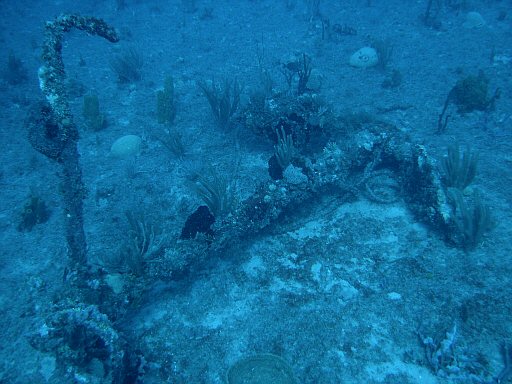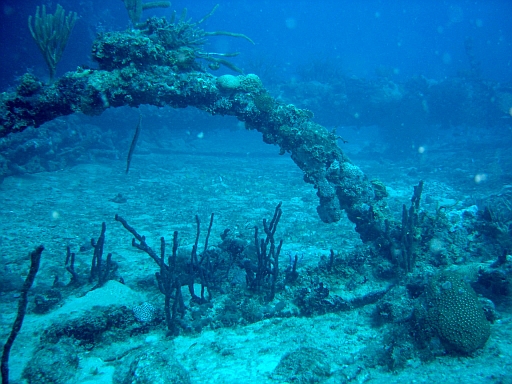Dives start with the deeper bow section and then move to the stern later. Anchors are visible directly under where the dive boat is moored.

---------------------------------------
The Royal Mail Steamship Rhone was commissioned in 1865 to provide transport of mail, passengers, and cargo between England and its colonies in the West Indies. Ahead of its time in many respects, the Rhone was a twin-masted schooner with the added ability to sail under propeller power at a time when most other ships were still paddle-driven. The ship fell victim to a hurricane two years later, taking all but six of its 300 man crew to the ocean bottom with it. While attempting to head out to open sea to weather the storm, the Rhone was pushed back onto Salt Island's Black Rock. Hull damage allowed cool seawater to come into contact with the ship's overheating boilers; the resulting violent explosion ripped the boat in half. In very Titanic-esque fashion, the bow and stern now rest in separate sections on the bottom of the ocean. The wreck is in waters shallow enough to permit visiting both sections, though several dives are necessary to take it all in.
Dives start with the deeper bow section and then move to the stern later. Anchors are visible directly under where the dive boat is moored.

---------------------------------------
An optical illusion of sorts. The bow section of the Rhone lies on its starboard side, so what appears to be ship's ribs are actually remnants of floorboard supports lying sideways as if straining to reach for the sea surface above. Haunting and mesmerizing, they are the most lasting impression of the dive.




---------------------------------------
Signal cannon.

---------------------------------------
Lifeboat davits with mast & crow's nest visible in the background.

---------------------------------------
Closeup of the crow's nest, lying on its side.

---------------------------------------
Bowsprit.

---------------------------------------
Another shot of the bow, this one looking back from the very front tip.

---------------------------------------
Glistening silversides visible from inside the ghostly interior of the hull.

---------------------------------------
Portals -- some with intact glass -- offer windows into the past.

---------------------------------------
A gray snapper swims by for a closer look.

---------------------------------------
Moving on to the stern section, which also features support beams twisted at odd angles.


---------------------------------------
The stern section lies completely splayed open, looking most vulnerable. Hovering as a small dot over these massive pieces of mangled debris is as good a reminder as any of just how powerful the ocean can be.

---------------------------------------
A few shots of the propeller shaft, gear box, and the massive 15 foot propeller itself.



---------------------------------------
A couple shots of happier times. First, a section of the black & white checkerboard pattern of the ship's dance floor is just visible under layers of algae. Below that the nearly intact glass of the portal of the honeymoon suite, routinely rubbed by all passing divers for good luck.


---------------------------------------
In the end, a nice symbol of the fact that life goes on. A colony of sergeant majors had laid patches of purple eggs all over the area, each clutch guarded dutifully by one of the caring parents.
